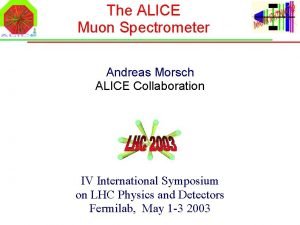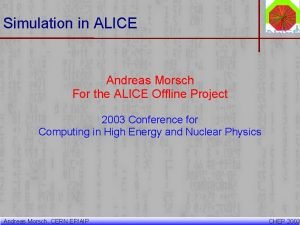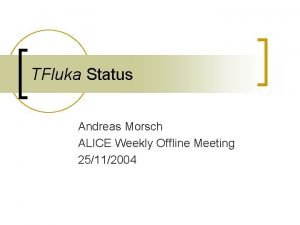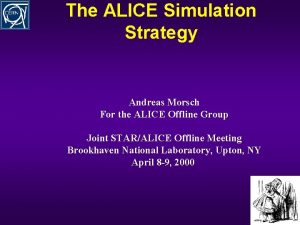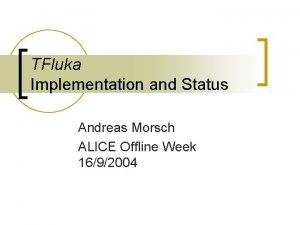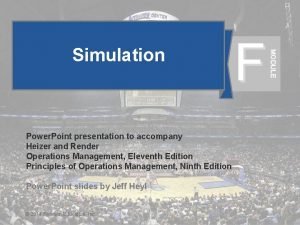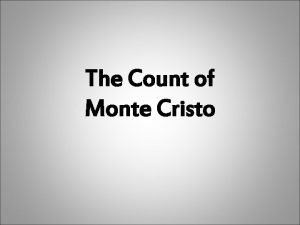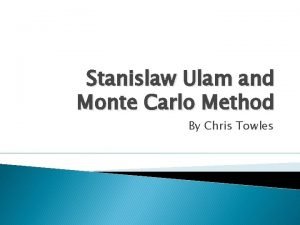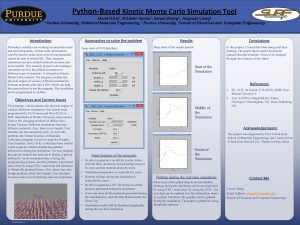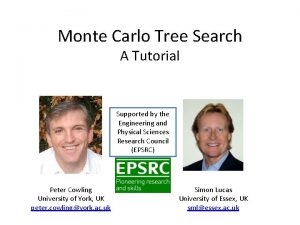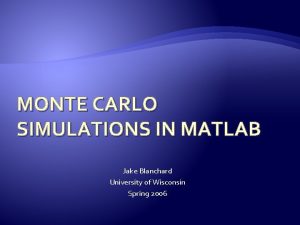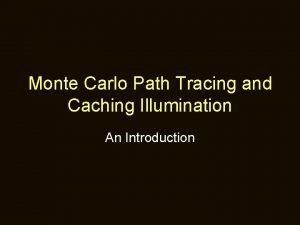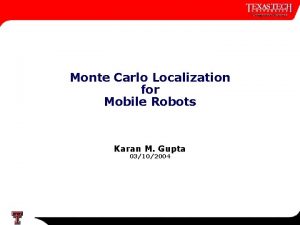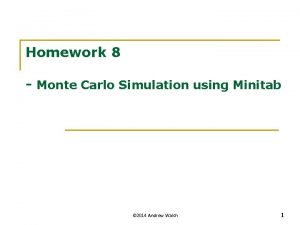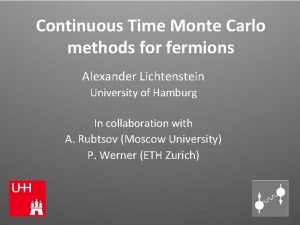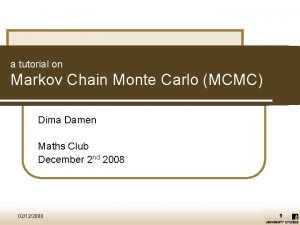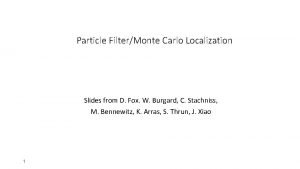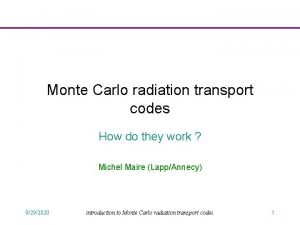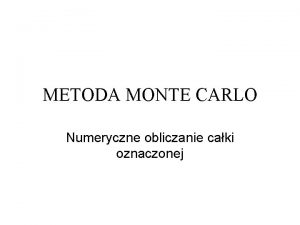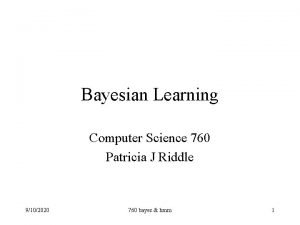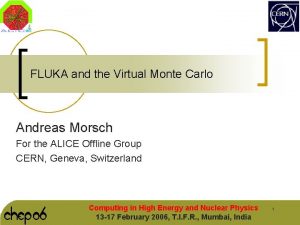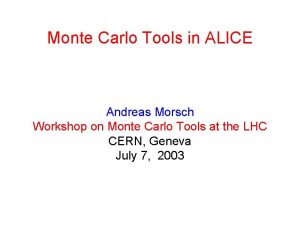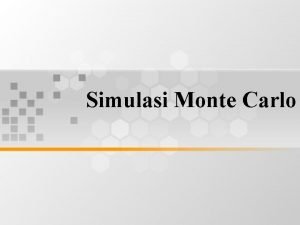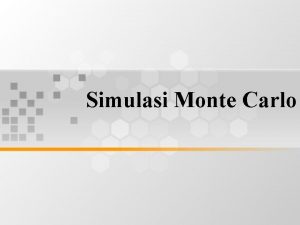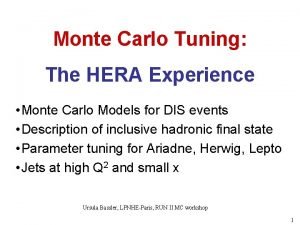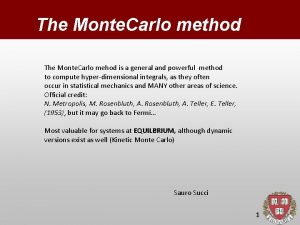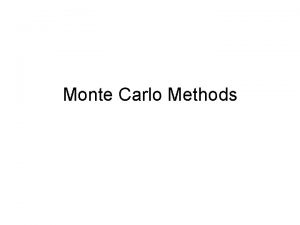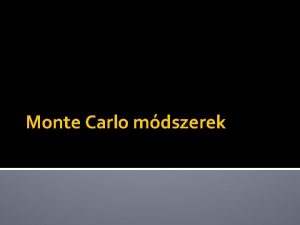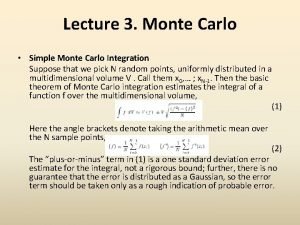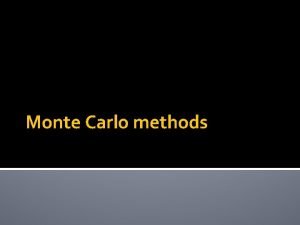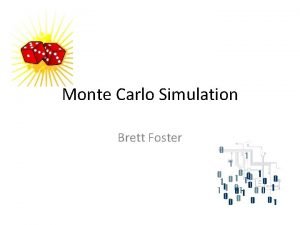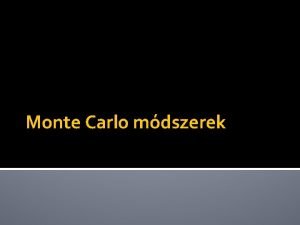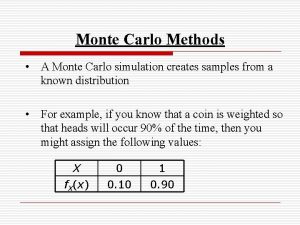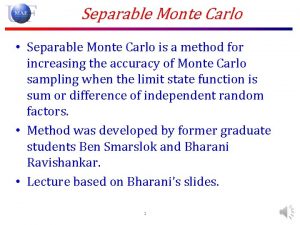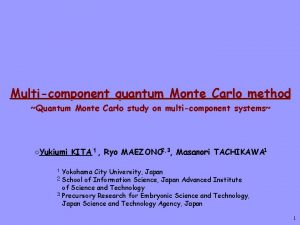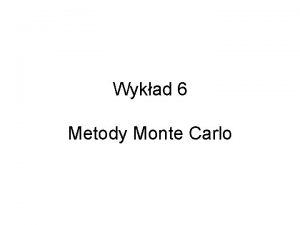FLUKA and the Virtual Monte Carlo Andreas Morsch






















- Slides: 22

FLUKA and the Virtual Monte Carlo Andreas Morsch For the ALICE Offline Group CERN, Geneva, Switzerland Computing in High Energy and Nuclear Physics 13 -17 February, T. I. F. R. , Mumbai, India

What is FLUKA ? n FLUKA Particle Transport Monte Carlo Code ¡ ¡ ¡ n Its state of the art physics capabilities comprise 1 ¡ ¡ n Hadron-hadron, hadron-nucleus, and g-nucleus interactions 0 -104 Te. V Nucleus-nucleus interactions 0 -104 Te. V/n Electromagnetic and µ interactions 1 ke. V-104 Te. V Neutrino interactions and nucleon decays FLUKA has proven capabilities in 1: ¡ ¡ ¡ 1 F. Has evolved since long into a mature system. Evolution based on thorough physics validation. Almost unique capabilities for simulating hadronic interactions including low-energy neutron transport Accelerator design and shielding (standard tool at CERN for beam-machine and Radioprotection studies Dosimetry and hadro-therapy Space radiation and cosmic ray showers in the atmosphere (Support by NASA, “de facto” standard tool for all aircraft dosimetry studies in Europe) Ballarini et al, INTERNATIONAL CONFERENCE ON NUCLEAR DATA FOR SCIENCE & TECHNOLOGY, 9/30/2004, Santa Fe

How is FLUKA used traditionally ? n For radiation studies ¡ Combinatorial geometry based on Boolean operation n In Alice: coarse geometry O(1000) volumes ¡ n n Definition of scoring volumes (binning) for dose, fluence, stardensities, … For full detector simulations ¡ ¡ No homogenous interface for user hit generation and stepping actions. Access to particle information during stepping n n 2 A. Task simplified using the ALIFE 2 script developed by ALICE Offline Through user routines called during transport Direct access to common block variables Morsch, “ALIFE: A Geometry Editor and Parser for FLUKA”, ALICE-INT-1998 -29

Integration of FLUKA into detector simulation frame-work n Advantages ¡ ¡ n Full detector simulation and radiation studies using the same detailed geometry Re-use of code for detector response simulation as already developed for Geant 3 Integration has been achieved using the ¡ ¡ Virtual Monte Interface 3 and The Root geometry modeler TGeo 3 http: //root. cern. ch/root/vmc/Virtual. MC. html

Virtual MC Concept n Transport MC transparent to the user application ¡ Base class TVirtual. MC User Code VMC TGeo Input GEANT 3 VMC GEANT 3 GEANT 4 VMC GEANT 4 FLUKA VMC FLUKA Particles Hits Output

VMC Class Design n But also the user application has to be transparent to the transport MC ¡ Base classes TVirtual. MCApplication, TVirtual. MCStack, TVirtual. MCDecayer TVirtual. MCApplication TVirtual. MCStack TVirtual. MCDecayer User. Stack Pythia 6 User. Application TGeant 3 TGeant 4 TFluka

VMC methods cover the following categories n g rat io pin u ep St nfi g Co Geometry n e rc u So Stacking P ic t r a F i e ld le n e tic M a g FLUKA In a traditional “FORTRAN” frame work ¡ User routines ¡ Common Blocks ¡ Configuration Files

FLUKA VMC implemenatation n n Implementation of TVirtual. MC methods Define the TVirtual. MC ↔TVirtual. MCApplication calling sequence ¡ Cannot be enforced by the VMC Interface n ¡ ¡ Avoid hidden dependencies on the application Has to be taken into account by any new realisation of TVirtual. MCApplication Needs detailed documentation (UML)

Initialisation TVirtual. MCApplication User Application Init. MC() (1) Geometry Creation Detector Code TVirtual. MC Init () Add. Particles() Construct. Geometry() Create. Geometry() Init() Build. Physics()

Simulation Run User Application TVirtual. MC Detector Code Generator Process. Run() Begin. Event() (2) Particle Generation (3) Stepping Generate. Primaries() Generate() Pre. Track() Field() Stepping() Step. Manager() Post. Track()

Class Structure TVirtual. MC TFluka. MCGeometry TFluka TGeo. MCGeometry TFluka. Config. Options TFluka. Scoring. Options TFluka TVirtual. MC realisation Physics Configuration Helper Classes for delegation of tasks

Interface to FLUKA: Geometry and Navigation TVirtual. MC TFluka. MCGeometry TFluka TGeo. MCGeometry TFluka User Application (1) Geometry Definition TGeo FLUKA (2) Navigation idnrwr g 1 rtwr conhwr inihwr jomiwr lkdbwr lkfxwr lkmgwr lkwr nrmlwr rgrpwr isvhwr magfld

Interface to FLUKA: Physics Configuration TVirtual. MC TFluka. Cerenkov TFluka User Application TFluka. Config. Option TFluka Text Input TFluka. Scoring. Option TFluka FLUKA

Interface to FLUKA: Stacking and Stepping Actions TVirtual. MC eedraw endraw mgdraw sodraw usdraw source TFluka (2) abscff dffcff queffc rflct rfrndx (3) TVirtual. MCApplication n Role of TVirtual. MCStack ¡ Common Blocks ¡ stupre stuprf (1) FLUKA ¡ Primary particle source for transport “Mirror” of secondaries created by FLUKA Source of user created particles (ex. feedback photons, TR photons)

A word of caution … n By its very nature an interface to a particle transport code cannot completely hide implementation choices. ¡ ¡ n Example: (Many-) Particle transport is parallel in nature and is sequenced by the transport code. The order of transport is an implementation choice exposed to the user. Handling of particles that have fallen below the energy cut for transport is another example. This can cause differences an the level of “Hits” but should disappear on the level of “Digits”.

G 3/FLUKA: Differences in Stepping Behavior Sensitive Volume 2 1 Geant 3 1: entering 1: exiting 2: entering 2: exiting FLUKA 1: entering 1: disappeared 2: entering 2: exiting 1: entering 1: exiting 2 hits 3 hits

Validation n Validation of geometry navigation via TGeo ¡ n Technical validation of the VMC implementation ¡ n Standard benchmark tests provided by FLUKA authors Comparison with G 3 results Physics validation ¡ Comparison with test-beam data

Al-Au-Al thin layers, low energy electron transport n Trivial geometry, simulate EM-cascade ¡ ¡ n No field 1 Me. V electrons along Z, all energy lost in material Z Comparison of shower profiles ¡ ¡ Identical run conditions Longitudinal and radial energy deposition distributions R

Electron transport in thin layers • 1000 electrons at 1 Me. V, EM cascades • Same final random number after simulations with FLUKA native and TFluka • The same for all 3 tested examples

FLUKA/G 3 Comparison n Good agreement where it is expected: ¡ Photons in electromagnetic shower log 10(step/cm) log 10(E/Ge. V)

Comparison with test-beam data ongoing Silicon Pixel Detector

Conclusions n n FLUKA VMC implementation completed Testing well advanced ¡ ¡ n TGeo/FLUKA validation completed Good agreement with G 3 and Testbeam FLUKA VMC will be used in the next ALICE Physics data challenge Many have contributed to this project. Special thanks to A. Abrahantes Quintana, F. Carminati, B. Dalena, R. Diaz Valdes, A. Fasso, E. Futo, A. Gheata, I. Hrivnakova, M. Gheata, I. Gonzalez Caballero, E. Lopez Torres, M. Lopez Noriega, D. Stocco
 Andreas morsch
Andreas morsch Andreas gheata
Andreas gheata Sodraq
Sodraq Andreas morsch
Andreas morsch Andreas morsch
Andreas morsch Monte carlo simulation advantages and disadvantages ppt
Monte carlo simulation advantages and disadvantages ppt Count of monte carlo
Count of monte carlo Ulam monte carlo
Ulam monte carlo Simulasi monte carlo ppt
Simulasi monte carlo ppt Mnemstudio
Mnemstudio Kinetic monte carlo python
Kinetic monte carlo python Connect 4 monte carlo tree search
Connect 4 monte carlo tree search Monte carlo simulation matlab
Monte carlo simulation matlab Eric veach thesis
Eric veach thesis Monte carlo localization for mobile robots
Monte carlo localization for mobile robots Minitab monte carlo simulation
Minitab monte carlo simulation Continuous time monte carlo
Continuous time monte carlo Markov chain monte carlo tutorial
Markov chain monte carlo tutorial Monte carlo localization python
Monte carlo localization python Monte carlo radiation transport
Monte carlo radiation transport Metoda monte carlo algorytm
Metoda monte carlo algorytm Monte carlo search tree
Monte carlo search tree Monte carlo search tree
Monte carlo search tree
